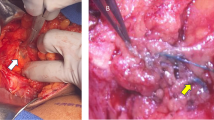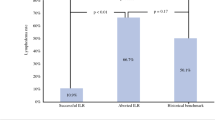Abstract
Purpose
Lymphedema is progressive arm swelling from lymphatic dysfunction which can occur in 30% patients undergoing axillary dissection/radiation for breast cancer. Immediate lymphatic reconstruction (ILR) is performed in an attempt decrease the risk of lymphedema in patients undergoing axillary lymph node dissection (ALND). The purpose of this study was to assess the efficacy of ILR in preventing lymphedema rates in ALND patients.
Methods
An institutional review board-approved retrospective review was performed of all patients who underwent ILR from 2017 to 2019. Patient demographics, comorbidities, operative and pathologic findings, number of LVAs, limb measurements, complications, and follow-up were recorded and analyzed. Student’s sample t-test, Fisher’s exact test, and ANOVA were used to analyze data; significance was set at p < 0.05.
Results
Thirty-three patients were included in this analysis. Three patients (9.1%) developed persistent lymphedema, and two patients (6.1%) developed transient arm edema that resolved with compression and massage therapy. A significant effect was found for body mass index and the number of lymph nodes taken on the development of lymphedema (p < 0.01).
Conclusions
The rate of lymphedema in this series was 9.1%, which is an improvement from historical rates of lymphedema. Our findings support ILR as a technique that potentially decreases the incidence of lymphedema after axillary lymphadenectomy. Obesity and number of lymph nodes removed were significant predictive variables for the development of lymphedema following LVA.

Similar content being viewed by others
References
Silva AK, Chang DW. Vascularized lymph node transfer and lymphovenous bypass: Novel treatment strategies for symptomatic lymphedema. J Surg Oncol. 2016;113(8):932–9.
Pusic AL, Cemal Y, Albornoz C, et al. Quality of life among breast cancer patients with lymphedema: a systematic review of patient-reported outcome instruments and outcomes. J Cancer Survivorship. 2013;7(1):83–92.
Feldman S, Bansil H, Ascherman J, et al. Single institution experience with lymphatic microsurgical preventive healing approach (LYMPHA) for the primary prevention of lymphedema. Ann Surg Oncol. 2015;22(10):3296–301.
Boccardo F, Casabona F, DeCian F, et al. Lymphatic microsurgical preventing healing approach (LYMPHA) for primary surgical prevention of breast cancer‐related lymphedema: over 4 years follow‐up. Microsurgery. 2014;34(6):421–4.
Golshan M, Martin WJ, Dowlatshahi K. Sentinel lymph node biopsy lowers the rate of lymphedema when compared with standard axillary lymph node dissection. Am Surg. 2003;69(3):209–211; discussion 212.
Cohen SR, Payne DK, Tunkel RS. Lymphedema: strategies for management. Cancer Interdisciplinary Int J Am Cancer Soc. 2001;92(S4):980–7.
Mehrara BJ, Zampell JC, Suami H, Chang DW. Surgical management of lymphedema: past, present, and future. Lymphatic Res Biol. 2011;9(3):159–67.
Boccardo F, Casabona F, De Cian F, et al. Lymphedema microsurgical preventive healing approach: a new technique for primary prevention of arm lymphedema after mastectomy. Ann Surg Oncol. 2009;16(3):703.
Boccardo FM, Casabona F, Friedman D, et al. Surgical prevention of arm lymphedema after breast cancer treatment. Ann Surg Oncol. 2011;18(9):2500–5.
Johnson AR, Kimball S, Epstein S, et al. Lymphedema incidence after axillary lymph node dissection: quantifying the impact of radiation and the lymphatic microsurgical preventive healing approach. Ann Plast Surg. 2019;82(4S):S234–41.
Hahamoff M, Gupta N, Munoz D, et al. A lymphedema surveillance program for breast cancer patients reveals the promise of surgical prevention. J Surg Res. 2019;244:604–11.
Casabona F, Bogliolo S, Menada MV, Sala P, Villa G, Ferrero S. Feasibility of axillary reverse mapping during sentinel lymph node biopsy in breast cancer patients. Ann Surg Oncol. 2009;16(9):2459.
Helyer LK, Varnic M, Le LW, Leong W, McCready D. Obesity is a risk factor for developing postoperative lymphedema in breast cancer patients. Breast J. 2010;16(1):48–54.
Norman SA, Localio AR, Kallan MJ, et al. Risk factors for lymphedema after breast cancer treatment. Cancer Epidemiol Prev Biomarkers. 2010;19(11):2734–46.
15. Crosby MA, Card A, Liu J, Lindstrom WA, Chang DW. Immediate breast reconstruction and lymphedema incidence. Plast Reconstr Surg. 2012;129(5):789e–95e.
Wilke LG, McCall LM, Posther KE, et al. Surgical complications associated with sentinel lymph node biopsy: results from a prospective international cooperative group trial. Ann Surg Oncol. 2006;13(4):491–500.
Meeske KA, Sullivan-Halley J, Smith AW, et al. Risk factors for arm lymphedema following breast cancer diagnosis in black women and white women. Breast Cancer Res Treat. 2009;113(2):383–91.
Ozaslan C, Kuru B. Lymphedema after treatment of breast cancer. Am J Surg. 2004;187(1):69–72.
Soran A, D’Angelo G, Begovic M, et al. Breast cancer‐related lymphedema–what are the significant predictors and how they affect the severity of lymphedema? Breast J. 2006;12(6):536543.
Hayes SB, Freedman GM, Li T, Anderson PR, Ross E. Does axillary boost increase lymphedema compared with supraclavicular radiation alone after breast conservation? Int J Radiat Oncol Biol Phys. 2008;72(5):1449–55.
Ridner SH, Dietrich MS, Stewart BR, Armer JM. Body mass index and breast cancer treatment-related lymphedema. Supportive Care Cancer. 2011;19(6):853–7.
Goldberg JI, Riedel ER, Morrow M, Van Zee KJ. Morbidity of sentinel node biopsy: relationship between number of excised lymph nodes and patient perceptions of lymphedema. Ann Surg Oncol. 2011;18(10):2866.
Herd-Smith A, Russo A, Muraca MG, Del Turco MR, Cardona G. Prognostic factors for lymphedema after primary treatment of breast carcinoma. Cancer. 2001;92(7):1783–7.
Paskett ED, Naughton MJ, McCoy TP, Case LD, Abbott JM. The epidemiology of arm and hand swelling in premenopausal breast cancer survivors. Cancer Epidemiol Biomarkers Prev. 2007;16(4):775–82.
Norman SA, Localio AR, Potashnik SL, et al. Lymphedema in breast cancer survivors: incidence, degree, time course, treatment, and symptoms. J Clin Oncol. 2009;27(3):390.
Qin ES, Bowen MJ, Chen WF. Diagnostic accuracy of bioimpedance spectroscopy in patients with lymphedema: a retrospective cohort analysis. J Plast Reconstr Aesthetic Surg. 2018;71(7):1041–50.
Mihara M, Hara H, Araki J, et al. Indocyanine green (ICG) lymphography is superior to lymphoscintigraphy for diagnostic imaging of early lymphedema of the upper limbs. PloS One. 2012;7(6).
Author information
Authors and Affiliations
Corresponding author
Ethics declarations
Disclosures
The authors have no COI or disclosures to report.
Additional information
Publisher's Note
Springer Nature remains neutral with regard to jurisdictional claims in published maps and institutional affiliations.
Rights and permissions
About this article
Cite this article
Cook, J.A., Sasor, S.E., Loewenstein, S.N. et al. Immediate Lymphatic Reconstruction after Axillary Lymphadenectomy: A Single-Institution Early Experience. Ann Surg Oncol 28, 1381–1387 (2021). https://doi.org/10.1245/s10434-020-09104-2
Received:
Accepted:
Published:
Issue Date:
DOI: https://doi.org/10.1245/s10434-020-09104-2




